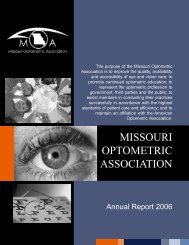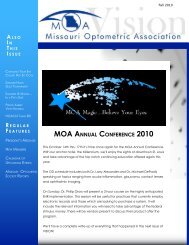October | November - Missouri Optometric Association
October | November - Missouri Optometric Association
October | November - Missouri Optometric Association
You also want an ePaper? Increase the reach of your titles
YUMPU automatically turns print PDFs into web optimized ePapers that Google loves.
<strong>October</strong> | <strong>November</strong> 2008<br />
HHS Proposes Adoption<br />
of ICD-10 Code Sets and<br />
Updated Electronic Transaction<br />
Standards<br />
by Rich Wilson<br />
According to HHS, the proposed new diagnoses<br />
codes, ICD-10, are designed to improve disease<br />
tracking and speed transition to an electronic<br />
health care environment. The new codes will<br />
become effective <strong>October</strong> 1, 2011, and will<br />
greatly expand the number of codes; allowing<br />
for quality reporting, pay-for-performance, biosurveillance,<br />
and other critical activities.<br />
In 2000 the ICD-9 codes, under authority<br />
provided by the Health Insurance Portability<br />
and Accountability Act of 1996 (HIPAA), code<br />
sets were adopted for use in the administrative<br />
transactions by both the public and private<br />
sectors to report diagnoses and inpatient hospital procedures. Covered entities<br />
required to use the ICD-9-CM code sets include health plans, health care<br />
clearinghouses, and health care providers who transmit any electronic health<br />
information in connection with a transaction for which a standard has been adopted<br />
by HHS.<br />
Having been developed three decades ago, ICD-9 is now viewed as outdated<br />
because of its limited ability to accommodate new procedures and diagnoses. ICD-9<br />
contains only 17,000 codes and is expected to start running out of available codes<br />
next year. In contrast, the ICD-10 code sets contain more than 155,000 codes and<br />
accommodate a host of new diagnoses and procedures. The additional codes will<br />
help to enable the implementation of electronic health records because they will<br />
provide more detail in the electronic transactions.<br />
Implementing these new codes will cost practices money for software changes,<br />
training, and lost revenue while learning how to use the new system. Cost<br />
estimates are divided by the size of the practice: A typical “small” practice is<br />
comprised of three physicians and two impacted administrative staff, a typical<br />
“medium” practice is comprised of 10 providers, one full-time coder, and six<br />
impacted administrative staff, and a typical “large” practice, comprised of 100<br />
providers, with 64 coding staff comprised of 10 full-time coders and 54 impacted<br />
medical records staff.<br />
10<br />
Continued, see HHS page 21
















